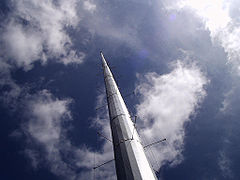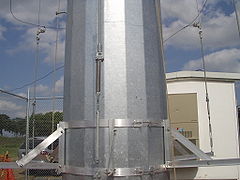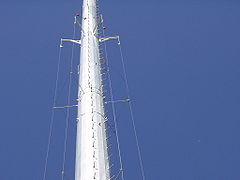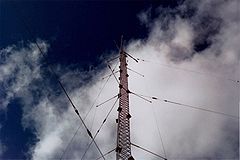
Folded unipole antenna
Encyclopedia
The folded-unipole antenna was first devised for broadcast use by the late John H. Mullaney, an American radio broadcast pioneer, and consulting engineer. A variation of a monopole antenna
, it consists of a vertical metal rod or mast mounted over a conductive surface called a ground plane
. The mast is surrounded by a "skirt" of vertical wires electrically attached to the top of the mast. The wires are connected together by a metal ring at the bottom and the feed line is connected between the bottom of the wires and ground. Designed to solve some difficult problems with existing medium wave (MW) amplitude modulation
(AM) broadcast antenna installations, it has seen much use, both in the United States
and other countries as well.
 A typical AM broadcast antenna is a series-fed monopole antenna
A typical AM broadcast antenna is a series-fed monopole antenna
above a ground system. The ground system normally comprises 120 buried copper or phosphor bronze radial wires at least one-quarter wavelength long and a ground-screen in the immediate vicinity of the tower. All the ground system components are bonded together, usually by brazing or using coin silver solder to minimize corrosion. These antennas have insulated bases. If required, insulated guy wires are used. Radio frequency power is fed across the base insulator between the ground system and the tower itself. In the US, the Federal Communications Commission
(FCC) required that the transmitter power measurements for a single series-fed tower calculated at this feed point as the current squared multiplied by the resistive part of the feed-point impedance.

 Electrically short
Electrically short
monopole antennas have low resistance and high reactance. Longer antennas may have impedances that are more advantageous unless the electrical height exceeds about 5/8 of a wavelength. In any case, an electrical network at the base of the tower matches the antenna to its transmission line. If the tower is very short, it will have its capacitive reactance tuned out by this matching network. This network and tower combination often results in a narrow bandwidth, severely limiting the audio frequency fidelity of the radio station. Electrically short antenna systems have relatively small apertures and high losses. The cause of these losses is related to the relatively low radiation resistance of an electrically short radiator with respect to the r-f resistance of the ground system and matching networks, all of which are in series with the antenna current.
Some claims have been made that ground system losses are reduced for the folded unipole antenna. However the experimental work of Ronald Rackley, et al., have shown this to be incorrect. Such claims do not consider that for the same conditions, the total displacement current in the ground system is nearly the same for a folded unipole as for a conventional series-fed unipole. Therefore ground system losses for these two radiator configurations are very similar.
Using a folded unipole will increase the bandwidth of electrically short antennas because its feed-point comprises less reactance that needs to be tuned out. There are additional performance claims made by some when the resulting antenna allows most all of the reactance to be removed with a tuning-short, rather than electrical components in a tuning network.
 One usually constructs the folded-unipole from an existing monopole antenna by shorting out the base insulator, thus connecting the tower directly to the ground system. Then a series of vertical wires, typically four to eight, are installed from an attachment near the top of the tower, kept a constant distance from the tower by structural members containing insulators, then attached together near the bottom of the tower. The resulting skirt connects to the tower top and remains insulated throughout its entire length. The wires of the skirt connect together at the feed-point near the bottom.
One usually constructs the folded-unipole from an existing monopole antenna by shorting out the base insulator, thus connecting the tower directly to the ground system. Then a series of vertical wires, typically four to eight, are installed from an attachment near the top of the tower, kept a constant distance from the tower by structural members containing insulators, then attached together near the bottom of the tower. The resulting skirt connects to the tower top and remains insulated throughout its entire length. The wires of the skirt connect together at the feed-point near the bottom.
Below is another folded unipole antenna constructed from an existing series fed monopole. This antenna has only three folds comprising the skirt.
 A possible improvement over the basic folded-unipole antenna is the “self resonant” unipole antenna, described in .
A possible improvement over the basic folded-unipole antenna is the “self resonant” unipole antenna, described in .
Abstract: A self-resonant vertically polarized folded unipole antenna for long wave (LW), medium wave (MW) broadcasting and for the 160-meter amateur radio band with a grounded tower connected to radially descending fold wires terminated near the base of the tower in an open polygonal ring, possibly a C-ring with a reactive load in series with this ring. This reactance cancels the reactive component of the antenna input impedance causing the input impedance to appear resistive at the feed point. This leads to outstanding linearity and bandwidth up to and possibly exceeding plus or minus 16 kHz, sometimes exceeding plus and minus 20 kHz. The antenna is particularly useful for AM broadcasting of high quality music with response capable of being better than that of FM.
Another possible improvement to the folded-unipole is described in .
Bobby L. Cox II, Ph.D., and James R. Moser of Kintronic Laboratories have performed a folded-unipole study of considerable depth.
When a common tower is used for both AM and FM transmission, the folded-unipole is often a good choice. Since the base of the tower connects to the ground system, the transmission lines to any antennas mounted thereon run up the side of the tower with no isolation necessary. Another broadcast antenna that had a grounded base is the shunt-fed (or slant-wire) antenna. This antenna comprises a grounded tower with a feed-line wire attached at a point of approximate transmission-line match. A series capacitor tunes out the inductive reactance of this feed-line. When the folded-unipole antenna replaced the slant-wire fed antenna, a marked improvement of performance often occurred. This gave rise to the notion that folded-unipole antennas had power gains or other wonderful characteristics, not supported by engineering theory.
When a folded-unipole replaces an antenna of defective or otherwise compromised design, there will be an improvement in performance. Series-fed monopole antenna
sites require care, keeping weeds as short as possible, since weeds will dissipate radio frequency power, severely reducing antenna efficiency. Folded-unipole antenna sites are affected less by otherwise attenuating disturbances near the ground.
Monopole antenna
A monopole antenna is a class of radio antenna consisting of a straight rod-shaped conductor, often mounted perpendicularly over some type of conductive surface, called a ground plane. The driving signal from the transmitter is applied, or for receiving antennas the output voltage is taken,...
, it consists of a vertical metal rod or mast mounted over a conductive surface called a ground plane
Ground plane
In electrical engineering, a ground plane is an electrically conductive surface.-Radio antenna theory :In telecommunication, a ground plane structure or relationship exists between the antenna and another object, where the only structure of the object is a structure which permits the antenna to...
. The mast is surrounded by a "skirt" of vertical wires electrically attached to the top of the mast. The wires are connected together by a metal ring at the bottom and the feed line is connected between the bottom of the wires and ground. Designed to solve some difficult problems with existing medium wave (MW) amplitude modulation
Amplitude modulation
Amplitude modulation is a technique used in electronic communication, most commonly for transmitting information via a radio carrier wave. AM works by varying the strength of the transmitted signal in relation to the information being sent...
(AM) broadcast antenna installations, it has seen much use, both in the United States
United States
The United States of America is a federal constitutional republic comprising fifty states and a federal district...
and other countries as well.
Typical setup

Monopole antenna
A monopole antenna is a class of radio antenna consisting of a straight rod-shaped conductor, often mounted perpendicularly over some type of conductive surface, called a ground plane. The driving signal from the transmitter is applied, or for receiving antennas the output voltage is taken,...
above a ground system. The ground system normally comprises 120 buried copper or phosphor bronze radial wires at least one-quarter wavelength long and a ground-screen in the immediate vicinity of the tower. All the ground system components are bonded together, usually by brazing or using coin silver solder to minimize corrosion. These antennas have insulated bases. If required, insulated guy wires are used. Radio frequency power is fed across the base insulator between the ground system and the tower itself. In the US, the Federal Communications Commission
Federal Communications Commission
The Federal Communications Commission is an independent agency of the United States government, created, Congressional statute , and with the majority of its commissioners appointed by the current President. The FCC works towards six goals in the areas of broadband, competition, the spectrum, the...
(FCC) required that the transmitter power measurements for a single series-fed tower calculated at this feed point as the current squared multiplied by the resistive part of the feed-point impedance.


Electrically short
An electrically short antenna is an antenna of length 2h, such that2 \pi h\over\lambda \scriptstyle\ll 1.An electrically short transmission line is a transmission line in which all of its effects will complete within one cycle of an impressed alternating current....
monopole antennas have low resistance and high reactance. Longer antennas may have impedances that are more advantageous unless the electrical height exceeds about 5/8 of a wavelength. In any case, an electrical network at the base of the tower matches the antenna to its transmission line. If the tower is very short, it will have its capacitive reactance tuned out by this matching network. This network and tower combination often results in a narrow bandwidth, severely limiting the audio frequency fidelity of the radio station. Electrically short antenna systems have relatively small apertures and high losses. The cause of these losses is related to the relatively low radiation resistance of an electrically short radiator with respect to the r-f resistance of the ground system and matching networks, all of which are in series with the antenna current.
Some claims have been made that ground system losses are reduced for the folded unipole antenna. However the experimental work of Ronald Rackley, et al., have shown this to be incorrect. Such claims do not consider that for the same conditions, the total displacement current in the ground system is nearly the same for a folded unipole as for a conventional series-fed unipole. Therefore ground system losses for these two radiator configurations are very similar.
Using a folded unipole will increase the bandwidth of electrically short antennas because its feed-point comprises less reactance that needs to be tuned out. There are additional performance claims made by some when the resulting antenna allows most all of the reactance to be removed with a tuning-short, rather than electrical components in a tuning network.

Below is another folded unipole antenna constructed from an existing series fed monopole. This antenna has only three folds comprising the skirt.

Abstract: A self-resonant vertically polarized folded unipole antenna for long wave (LW), medium wave (MW) broadcasting and for the 160-meter amateur radio band with a grounded tower connected to radially descending fold wires terminated near the base of the tower in an open polygonal ring, possibly a C-ring with a reactive load in series with this ring. This reactance cancels the reactive component of the antenna input impedance causing the input impedance to appear resistive at the feed point. This leads to outstanding linearity and bandwidth up to and possibly exceeding plus or minus 16 kHz, sometimes exceeding plus and minus 20 kHz. The antenna is particularly useful for AM broadcasting of high quality music with response capable of being better than that of FM.
Another possible improvement to the folded-unipole is described in .
Bobby L. Cox II, Ph.D., and James R. Moser of Kintronic Laboratories have performed a folded-unipole study of considerable depth.
When a common tower is used for both AM and FM transmission, the folded-unipole is often a good choice. Since the base of the tower connects to the ground system, the transmission lines to any antennas mounted thereon run up the side of the tower with no isolation necessary. Another broadcast antenna that had a grounded base is the shunt-fed (or slant-wire) antenna. This antenna comprises a grounded tower with a feed-line wire attached at a point of approximate transmission-line match. A series capacitor tunes out the inductive reactance of this feed-line. When the folded-unipole antenna replaced the slant-wire fed antenna, a marked improvement of performance often occurred. This gave rise to the notion that folded-unipole antennas had power gains or other wonderful characteristics, not supported by engineering theory.
When a folded-unipole replaces an antenna of defective or otherwise compromised design, there will be an improvement in performance. Series-fed monopole antenna
Monopole antenna
A monopole antenna is a class of radio antenna consisting of a straight rod-shaped conductor, often mounted perpendicularly over some type of conductive surface, called a ground plane. The driving signal from the transmitter is applied, or for receiving antennas the output voltage is taken,...
sites require care, keeping weeds as short as possible, since weeds will dissipate radio frequency power, severely reducing antenna efficiency. Folded-unipole antenna sites are affected less by otherwise attenuating disturbances near the ground.
See also
- isotropic antenna
- omnidirectional antennaOmnidirectional antennaIn radio communication, an omnidirectional antenna is an antenna which radiates radio wave power uniformly in all directions in one plane, with the radiated power decreasing with elevation angle above or below the plane, dropping to zero on the antenna's axis. This radiation pattern is often...
- whip antennaWhip antennaA whip antenna is an antenna consisting of a single straight flexible wire or rod, often mounted above some type of conducting surface called a ground plane. The bottom end of the whip is connected to the radio receiver or transmitter. They are designed to be flexible so that they won't break...
- driven elementDriven elementIn a multielement antenna array , the driven element or active element is the element in the antenna which is electrically connected to the receiver or transmitter. In a transmitting antenna it is driven or excited by the RF current from the transmitter, and is the source of the radio waves...
- monopole antennaMonopole antennaA monopole antenna is a class of radio antenna consisting of a straight rod-shaped conductor, often mounted perpendicularly over some type of conductive surface, called a ground plane. The driving signal from the transmitter is applied, or for receiving antennas the output voltage is taken,...
- balunBalunA balun is a type of electrical transformer that can convert electrical signals that are balanced about ground to signals that are unbalanced , and the reverse. They are also often used to connect lines of differing impedance...
- amateur radioAmateur radioAmateur radio is the use of designated radio frequency spectrum for purposes of private recreation, non-commercial exchange of messages, wireless experimentation, self-training, and emergency communication...
- shortwave listeningShortwave listeningShortwave listening is the hobby of listening to shortwave radio broadcasts located on frequencies between 1700 kHz and 30 MHz. Listeners range from casual users seeking international news and entertainment programming to hobbyists immersed in the technical aspects of radio reception and DXing...
External links
- http://www.mullengr.com
- http://www.nottltd.com
- http://www.rainesengineering.com

